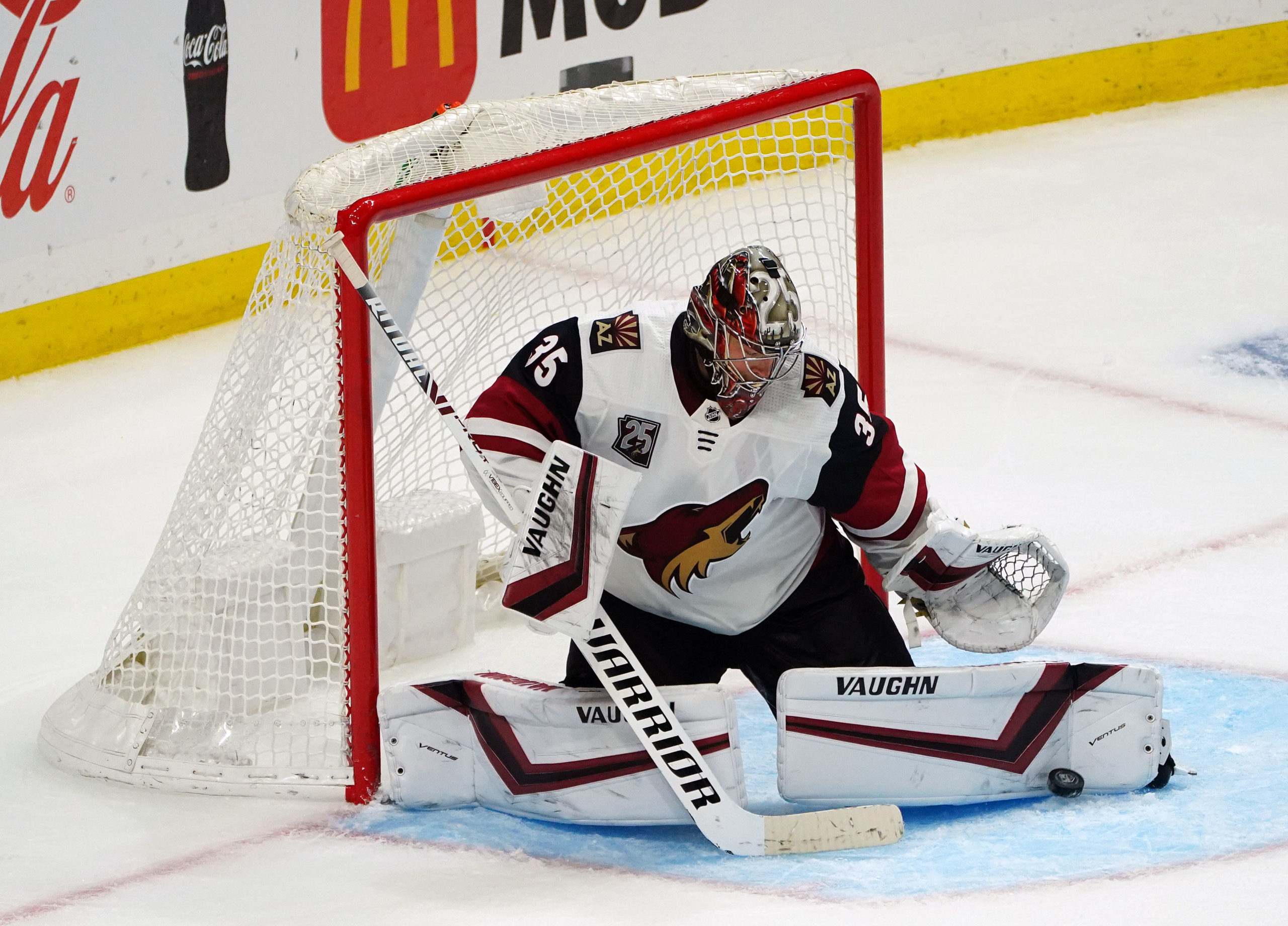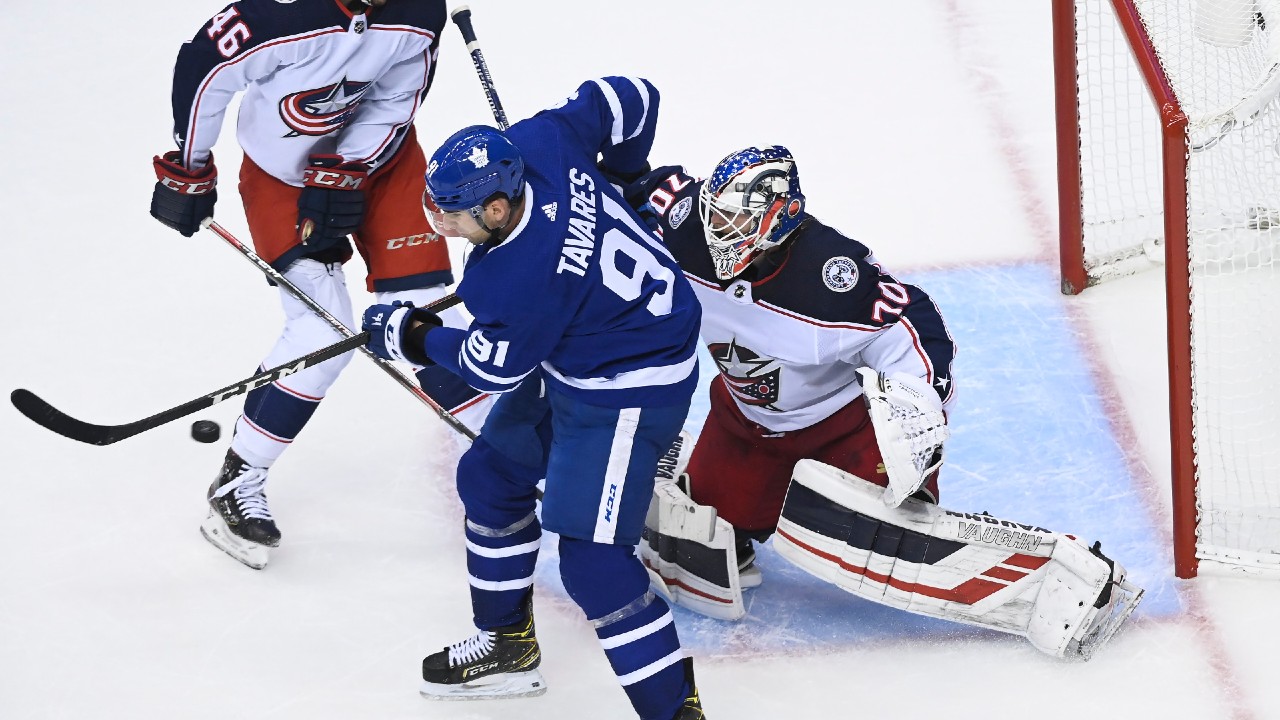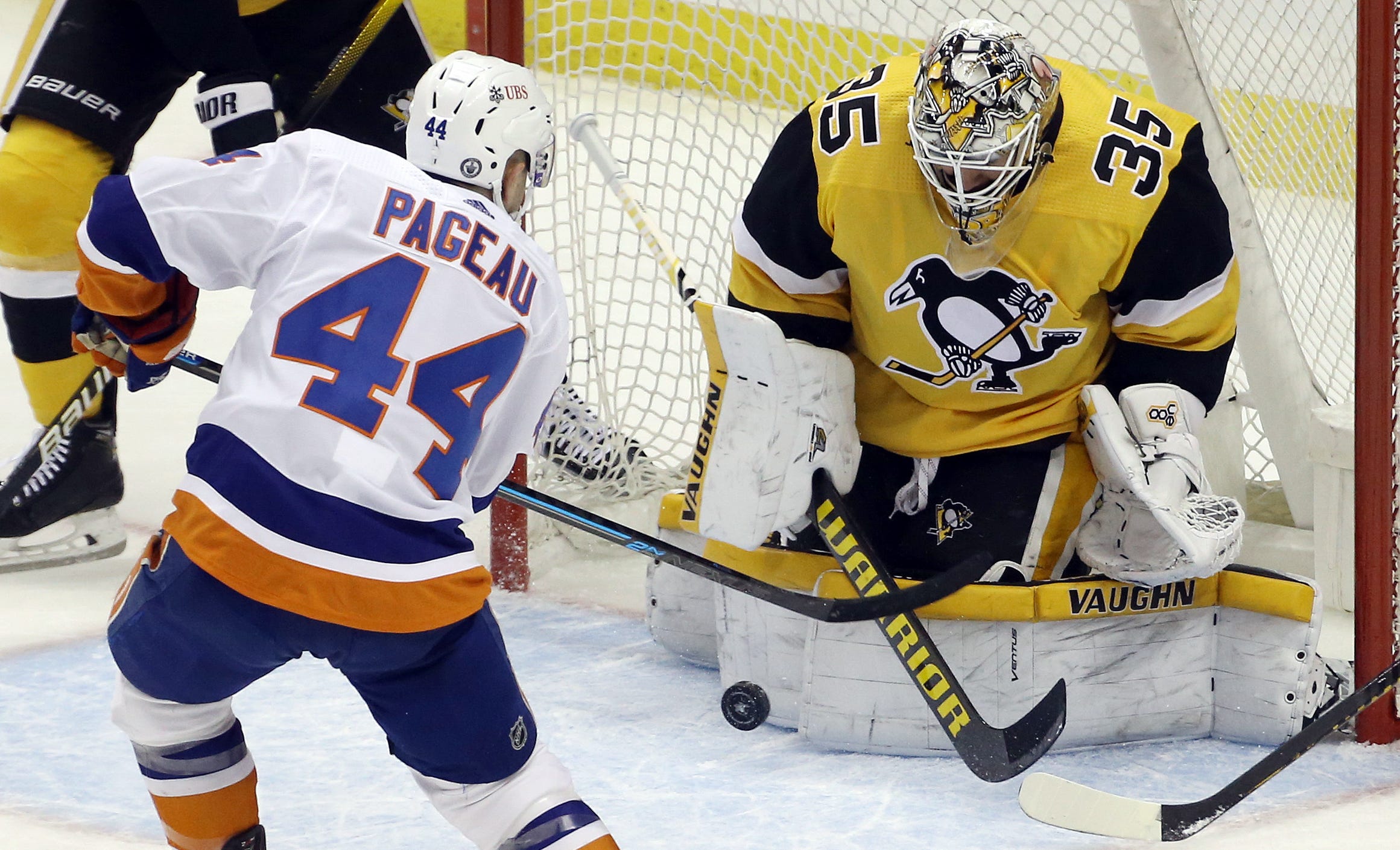In yesterday’s article, we covered the Maple Leafs’ options for filling their second-goalie vacancy, including the incumbent candidate in Frederik Andersen as well as pending UFAs Chris Driedger, Linus Ullmark, Petr Mrazek, Antti Raanta, Laurent Brossoit, and more.
Today, let’s dive into the trade market and some other long-shot possibilities.
Trade Options

Darcy Kuemper (one year, $4.5 million)
The Coyotes are in the market for draft picks. They don’t have a prospect from the first four rounds of last year, and they lost their first-round pick in 2021 as a result of violating the league’s combine testing rules. Given that Kuemper is a one-year rental and 25-year old Adin Hill is coming off of a strong season, there’s a reasonable chance that Kuemper will be moved this offseason. After all, Arizona can only protect one of the two in the expansion draft.
Kuemper has high-end upside. He posted a .925 save percentage in 55 games in the 2018-19 season followed by a .928 save percentage in 29 games in 2019-20. He boasts a career save percentage of .917 across 242 NHL games, so it’s not like those were his only strong seasons, either.
The downside to Kuemper is the price. When you combine a $4.5 million cap hit with what you’d have to give up in a trade, you’re paying up for a good starter. He’s only played 35 games in an NHL season twice, and he’s coming off a year in which he posted a .907 save percentage and dealt with an injury. He played quite well for Canada at the World Championships, but there’s certainly a chance that you give up a haul and get another injury-riddled mediocre season.
The Leafs aren’t exactly flush with draft capital right now with only have three picks in each of the next two drafts. They could acquire more picks by dealing from other areas — or trade prospects to Arizona instead — but the two teams aren’t exactly ideal trading partners right now.
The Leafs could also offer one year of Morgan Rielly in exchange for one year of Darcy Kuemper, but they’d want the Coyotes to add to the deal. If Arizona ends up trading Oliver Ekman-Larsson, maybe it becomes a possibility, but that type of blockbuster trade is probably a long shot.
If Kuemper is a Vezina candidate next season, every team in the league will be kicking themselves for not trading for him. However, I expect the Leafs to go into next season with Jack Campbell as their #1 starter and look for a cheaper option to supplement him. If they do trade picks and prospects, I expect them to target forward help rather than Kuemper.
Unless the Leafs were to strike some sort of deal with Seattle, Kuemper probably isn’t a fit. If the Leafs trade for Kuemper before the expansion draft, they would have to expose Jack Campbell, which isn’t happening.
However, I suspect that the Coyotes would want to move Kuemper before the expansion draft, allowing them to protect Hill. I’ll be a bit surprised if this trade happens this offseason, but if Kuemper is available at the deadline and the Leafs look like they need a goalie, I can definitely see a trade happening at that time.
Elvis Merzlikins (one year, $4 million)
Merzlikins is quite similar to Kuemper: a one-year rental who will cost a bit of a haul in a trade. He boasts a .920 save percentage through 61 career NHL games, including a .916 in 28 games last season. Given that he’s only 27, the Blue Jackets could look to extend him, as he could be a major part of their future. However, if they don’t think they can sign him, they’re pretty much bound to trade him.
While he doesn’t have much of a track record, he’s been excellent to start his career and there’s no real reason to doubt him at the moment. The price would certainly be high, though, and like Kuemper, the cost might end up being too prohibitive for a team that already likes their #1 goalie. If the Leafs are trading picks and prospects for a rental, a forward might make more sense.
Similar to the Kuemper situation, I expect the Leafs to go into next season with Jack Campbell as their #1 starter and look for a cheaper option to supplement him. However, if Merzlikins is available at the deadline and the Leafs look like they need a goalie, I can definitely see a trade happening at that time. He’s worth calling about after the expansion draft, but he probably won’t be cheap.
Alexandar Georgiev (one year, $2.45 million – expires RFA)
Igor Shesterkin is the new starter in New York, but since he’s exempt from the expansion draft, the Rangers will be able to protect the 25-year old Georgiev. This likely increases his chances of being traded to a team like the Leafs — they plan on protecting Campbell, so making a trade after the expansion draft makes far more sense for them. In contrast, someone like Kuemper might be on the move before the expansion draft, making a team like the Oilers probably a better fit than the Leafs knowing Edmonton doesn’t really have to worry about protecting another goalie.
Georgiev posted a .905 save percentage in 19 games this season, but he was better in previous years and boasts a .912 save percentage through 96 career games. His $2.45 million cap hit would certainly appeal to the Leafs, and if he has a good season, he’s young enough to potentially stick around as their goalie of the future. He’s been slightly below average in each of the past few seasons by Evolving Hockey’s goals saved above average, but it’s worth noting that he’s still quite young.
Georgiev just turned 25 in February. Frederik Andersen was 24 during his rookie season — his first full NHL season came at the age of 25 — and Jack Campbell wasn’t an NHL regular until he was 26. Ultimately, if the Leafs do end up trading for Georgiev, it’s probably more of a scouting decision than an analytics one.
The Rangers could simply turn back to a Shesterkin-Georgiev duo next season. However, Georgiev isn’t “the guy” in New York, and he’s just two years away from unrestricted free agency. They need help at center, so perhaps they’re high on someone like Alex Kerfoot.
The Rangers have held off on trading Georgiev in the past — I still think he’s likely to stay put — but perhaps they’ve soured on him a bit after a disappointing season.
Ilya Samsonov and Vitek Vanecek
Samsonov and Vanecek are 24 and 25, respectively, and since they’re both Washington Capitals, one will be exposed in the expansion draft. Samsonov is a restricted free agent this season, but after posting a .902 save percentage in 19 games, he’ll be quite affordable on his next contract. Vanecek is an RFA next offseason with a cap hit of just $717k for next year. If the Leafs like either goalie enough, they can probably make a good enough offer to keep one of them from Seattle.
Samsonov is a former first-round pick who will likely be protected in the expansion draft. However, he only has a .908 save percentage through 48 career games, including a .902 save percentage in 19 games this season. Given that he’s only 24, Washington probably still sees him as their goalie of the future, but there’s at least an outside chance that they prefer Vanecek.
Vanecek posted a .908 save percentage in 37 games as a rookie. While he wasn’t a first-round pick like Samsonov was, he was the 39th pick in the 2014 draft, so there’s not a massive difference between the two in draft pedigree. A main selling point on Vanecek is his cap hit — if the Leafs spend just $717k on their backup goalie position, they’re going to have extra money to spend elsewhere.
Ultimately, this comes down to scouting. By the numbers, these probably aren’t the best options to backup Campbell next season. However, given their age as well as their status as former top goalie prospects, perhaps the Leafs feel like a breakout is on the horizon.
There is a chance that Vanecek isn’t selected in the expansion draft, but the Capitals want to add a veteran goalie and end up trading him anyway. There’s also a chance that Seattle grabs Vanecek but is willing to trade him.
Tristan Jarry and Casey DeSmith
Jarry has two years left on his deal at a $3.5 million cap hit, while DeSmith has one year left at $1.25 million. After Jarry struggled mightily in the playoffs, I expect the Penguins to add a goalie this offseason rather than running the same duo back. While Pittsburgh can only protect one of their two goalies in the expansion draft, it looks like the team will have to expose a pretty good forward or two as well, so Seattle might not end up taking either of them.
Jarry posted a .909 save percentage in 39 games this season before falling apart in six playoff games. That’s not overly appealing, but he’s just one season removed from a .921 save percentage in 33 games. Due to his $3.5 million cap hit, the Penguins could try to move Jarry and use the money to go after a true #1 goalie.
The cap hit is a little bit more expensive than what you’d see from many of the names on this list, but he’s only 26, and the Leafs may think that they can buy low on him following his rough playoff performance.
DeSmith underwent core muscle surgery this month but is expected to be ready for the start of next season. He boasts a .916 save percentage through 70 career games, including a .912 save percentage in 20 games last season. Given his lower cap hit, I expect that the Penguins will choose to keep him over Jarry. However, if they do want to go out and add another goalie — and they still like Jarry — he’s destined to be traded.
Robin Lehner (four years, $5M AAV)
This one is a bit of a long shot — especially if the Leafs are on his eight-team no-trade list — but Marc-Andre Fleury is coming off of an excellent season and Vegas has been pretty ruthless when it comes to trades.
While Lehner posted a respectable .913 save percentage in 19 games this season, he did take a step back in 2020-21, and Vegas could potentially opt to use the cap space elsewhere.
Lehner posted a .930 save percentage in 36 games back in the 2018-19 season with the New York Islanders. He followed that up with a .918 save percentage in 33 games for the Blackhawks, which led to a midseason trade to the Golden Knights. His track record is extensive with a .917 save percentage across 322 career games.
Lehner, 30 in July, is signed to a contract that will expire prior to his 34th birthday. At $5 million, the Leafs could consider shoring up their goaltending position for the next few years at a reasonable price. He could form a strong 1-2 punch with Campbell — just as he has done with Fleury — and since he’s not paid like Vasilevskiy, the Leafs could still potentially re-sign Campbell after next season.
Vegas doesn’t have to give up a player in the expansion draft, so we can take that out of the equation here. Could a deal involving one year Morgan Rielly, four years of Lehner, and other pieces interest both sides?
This one is a bit of a long shot, but if the Leafs love his game, they could probably make something work. As I said above, I expect the Leafs to go with a cheaper option to supplement Campbell.
Other Options

All the players in this section are long shots, but I’ll quickly run through them.
David Rittich probably isn’t good enough. Coming off of a down season, his best year was when he posted a .911 save percentage back in 2018-19. Like Reimer, the Leafs could consider him if he’s willing to sign for close to the league minimum, but I think they’re looking for a little bit more upside here.
Pekka Rinne will be 39 in November and hasn’t been great over the past two years. Again, it’s tough to rule it out completely if he takes a steep discount, but this one seems like a bit of a long shot. I expect the Leafs to go with a younger option.
Tuukka Rask already expressed his desire to stay in Boston, and he’s probably out of Toronto’s price range anyway. Philipp Grubauer is a great goalie, but he’s almost surely out of Toronto’s price range as well. Meanwhile, Brian Elliott and Devan Dubnyk haven’t been good enough in recent years to warrant any consideration.
Joonas Korpisalo posted a .894 save percentage in 33 games last season, which just isn’t going to cut it. He’s been under .900 in three of the past four seasons, which probably takes him out of the conversation.
Adin Hill, who was mentioned in the Kuemper section earlier, posted a .913 save percentage in 19 games last season. Given that he just turned 25, I expect the Coyotes to trade Kuemper and protect Hill. I expect Seattle to take Hill if he’s exposed in the expansion draft, and since the Leafs have to protect Campbell, it doesn’t make much sense to trade for Hill prior to the draft. As a result, he’s probably a long shot, too.
Final Thoughts

With a million goalies available, it sure seems like we’re going to have a goalie carousel this offseason. The Leafs will likely make their move following the expansion draft, and if there’s a player who they really like, they may not wait long to make their move. They could try to be patient and wait out the market in an effort to get a better deal. However, given how important next season is, I think they’ll be after some of the better options available.
Many of the players on this list have been inconsistent year to year. For many of these options, it’s easy to envision them as the bargain of the offseason, but it’s also possible it ends in complete disaster. While I don’t want to simply chalk this decision up to “goaltending is voodoo,” one look at Sergei Bobrovsky’s 7 x $10 million contract should tell you that this position is quite unpredictable.
A big question here: How much do the Leafs trust Jack Campbell? I’m a fan of his, but I think they need to be prepared for him to struggle. In flipping through 2019-20 stats from around the NHL, 17 goalies posted a .917 save percentage or better that season in 20+ games, which was the Freddy Andersen standard for years. Of those 17, two didn’t play this season and just seven recorded a save percentage over .910.
While Campbell certainly earned the #1 job this season, you’re asking for trouble if you have a below-average backup, especially since Campbell has never played 40+ games in an NHL regular season before. I’d go in with the mindset that there is close to a 50% chance that Campbell struggles a fair amount next season, whether through performance or injuries. Campbell may seem like he’s bound to be a good starter next season based on his previous year, but so did Markstrom, Khudobin, Kuemper, Raanta, and Koskinen last offseason.
I don’t think Smith or Reimer are good enough. Raanta would be very risky unless your medical staff is convinced that he’s back to 100%. Halak would also be quite risky given his age and rough 2020-21 season. I’m fine with taking those risks for the right price, but they better find a good third-string goalie in that case.
Ullmark, who stands out in terms of 5v5 goals saved above average, may be worth paying a little bit extra for. Merzlikins also stands out by this statistic and is worth calling about after the expansion draft.
If Ullmark and Merzlikins are too expensive, I’m not sure that I see a massive difference between the majority of the other options. Driedger has been great in a small sample, making all of us curious about his next contract. Bernier and Mrazek were both pretty good this season in a small sample, but I see them as more of a backup plan. It’s certainly possible that Raanta and Halak have strong seasons as well.
My goal if I was Kyle Dubas would be simple: get someone who you feel can potentially be the game one playoff starter if Campbell has a down season. In my view, the Leafs need a 1B rather than a true backup.
While it’s tempting to spend more elsewhere, goaltending is the most important position in hockey, and it doesn’t seem outrageous to spend $3-4.5 million on the right fit.


![Jim Montgomery Post Game, Bruins 4 vs. Leafs 2: “[Marchand] still manages to get under people’s skin, yet he doesn’t cross the line” Jim Montgomery, Boston Bruins post game](https://mapleleafshotstove.com/wp-content/uploads/2024/04/jim-monty-pg-to-218x150.jpg)
























![Jim Montgomery Post Game, Bruins 4 vs. Leafs 2: “[Marchand] still manages to get under people’s skin, yet he doesn’t cross the line” Jim Montgomery, Boston Bruins post game](https://mapleleafshotstove.com/wp-content/uploads/2024/04/jim-monty-pg-to-100x70.jpg)







